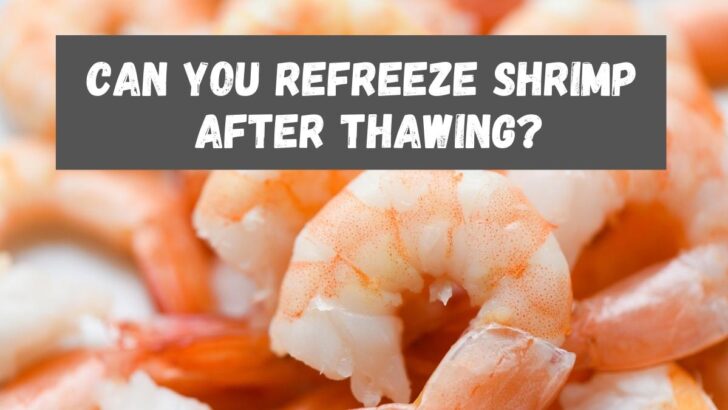Ever left your shrimp out after thawing and wondered if it’s still safe to eat? I’ve been there too! As a cooking enthusiast who works with seafood regularly, I’ll share everything you need to know about safely handling thawed shrimp.
The 2-Hour Rule: What You Need to Know
Here’s the simple truth thawed shrimp should never sit out at room temperature for more than 2 hours This is a strict food safety guideline from the USDA that we need to follow to prevent foodborne illness,
If your room is extra warm (above 90°F/32°C), that window shrinks to just 1 hour!
Signs Your Thawed Shrimp Has Gone Bad
When shrimp sits out too long, it’ll show these warning signs:
- A strong, unpleasant fishy smell
- Slimy or sticky texture
- Color changes from translucent to milky/yellow
- Soft, mushy flesh
If you spot any of these signs, it’s best to toss the shrimp. Trust me, food poisoning ain’t fun!
Safe Ways to Thaw Shrimp
Let’s talk about the right ways to thaw your shrimp:
1. Refrigerator Method (Best Option)
- Place frozen shrimp in fridge overnight
- Keeps shrimp at safe temperature
- Can last 1-2 days after thawing
2. Cold Water Method (Quick Option)
- Submerge sealed bag in cold water
- Change water every 30 minutes
- Cook immediately after thawing
3. Microwave Method (Last Resort)
- Use defrost setting
- Watch carefully to prevent cooking
- Must cook right away
❌ Never thaw shrimp at room temperature on the counter!
Proper Storage After Thawing
Once your shrimp is thawed, here’s how to store it properly:
- Use an airtight container
- Keep refrigerator temperature below 40°F
- Store on bottom shelf
- Use within 1-2 days
- Don’t mix old and new shrimp
What About Refreezing?
While you can technically refreeze thawed shrimp, I wouldn’t recommend it. Here’s why:
- Quality suffers big time
- Texture becomes rubbery
- Moisture loss increases
- Higher risk of bacterial growth
If you must refreeze, only do it once and use within 3-4 months.
Special Cases: Raw vs Cooked Shrimp
Raw Thawed Shrimp:
- Maximum 2 days in fridge
- Must cook thoroughly
- More susceptible to bacteria
Cooked Thawed Shrimp:
- Lasts 3-4 days in fridge
- Can be eaten cold
- Still watch for spoilage signs
Using Thawed Shrimp in Cold Dishes
When making things like shrimp cocktail or salad:
- Use within 24 hours of thawing
- Keep refrigerated until serving
- Don’t let sit out during meals
- Return to fridge promptly
My Top Tips for Safe Shrimp Handling
- Always wash hands before handling
- Use separate cutting boards
- Keep workspace clean
- Check dates on packages
- When in doubt, throw it out!
FAQs About Thawed Shrimp
Q: Can I eat shrimp that was left out overnight?
Nope! Even if it still has ice crystals, the outer layers have been in the danger zone too long.
Q: What if my thawed shrimp smells slightly fishy?
A mild ocean smell is okay, but strong fishy or ammonia odors mean it’s spoiled.
Q: Does cooking kill all bacteria in questionable shrimp?
While cooking kills bacteria, it won’t eliminate toxins they’ve already produced. Don’t risk it!
Remember, proper handling of thawed shrimp is super important for food safety. When we follow these guidelines, we can enjoy our favorite shrimp dishes without worrying about getting sick. Stay safe and happy cooking!
Would you like me to explain anything in more detail?

Cold Water Quick Thawing
Though this is not our recommended method, if you are very pressed for time and you need that shrimp quickly, you can thaw in 5-8 minutes, depending on the size and quantity of the shrimp.
Heres how to safely quick thaw shrimp under cold running water:
- Use Cold Running Water: Place shrimp in a colander under cold running water.
- Wait: Wait for 5-8 minutes or until fully thawed, moving the shrimp around every 1-2 minutes.
- Drain: Drain the shrimp, pat them dry, and continue with your preparation.
The Importance of Properly Defrosting Shrimp
No matter if youre crafting a shrimp cocktail or trying out a new shrimp recipe, youll need to thaw your frozen shrimp. This is a crucial step to ensure your meal is safe and delicious, every time.
Improper thawing can turn your shrimp into a breeding ground for bacteria. This can happen if you leave your shrimp at room temperature – known as the “Danger Zone” – or thaw them in warm water. These methods cause the outer layer of shrimp to warm up faster than the inside.
Similarly, thawing shrimp too quickly or at a high temperature can cause your seafood to become mushy. It affects their natural firmness and causes them to lose more moisture when cooked, leading to an unappealing texture.
